Have you ever wondered what AMPK and mTOR are, how they work and what they are for? Today we will explain it to you and give you the answer.
What are AMPK and mTOR
AMPK and mTOR are two biomolecular regulators of metabolism that aim to achieve energy balance depending on the scenario in which we find ourselves:
- the AMPK predominates over the mTOR at kilometer 30 of a marathon.
- mTOR predominates over AMPK after a nutrient-rich post-workout meal.
Both concepts have been very misrepresented by the media, trying to minimize a complex field like transcriptomics.
First of all, I would like to say that this article will address a basic and superficial approach to these concepts, in language that is as understandable as possible.
It should be borne in mind that we are talking about an extremely complex field of study and which requires a strong understanding of fields such as metabolomics or proteomics.
Let’s Get Started !
What-AMPK
AMPK is a protein kinase with a serine / threonine domain that acts as a regulator, a key sensor in cellular energy regulation and its activation promotes catabolism and inhibits anabolism , increasing the energy production of substrates and inhibiting energy consumption in reduction reactions.
AMPK stands for AMP-activated protein kinase.
AMP is a by-product of the breakdown of ATP , our energy currency.
So, when intracellular AMP concentrations increase, it means that the ATP: AMP ratio decreases , and it is an energy deprivation signal that activates AMPK by binding to the receptors of its AMP-related gamma subunit.
AMPK consists of 3 subunits (alpha, beta and gamma) , each related to a different marker; and in turn, each of the subunits is composed of subtypes of subunits, having alpha 1, 2; beta 1, 2; gamma 1, 2, 3 …
AMPK is also a concept that is used in a generalized but incorrect way since AMPK is a family of 13 kinases that we can find in the human genome and we have to specify to which of the isoforms we are referring to avoid confusion.
Even so, in this article AMPK will be treated as a generic concept in order not to thicken the subject.
But it is important to understand that AMPK is not something simple and static, but a compendium of proteins, with units and subunits that perform specific functions and are heterogeneously distributed in the tissues of the organism.
What is mTOR
mTOR is a protein kinase with a serine / threonine domain that forms functional complexes with other proteins, so it is known as mTORCx, which a in turn is expressed in two sub-complexes :
- mTORC1
- mTORC2
Each has specific subunits : mTOR, Raptor, mLST8, PRAS40; and mTOR, Rictor, mSin1, Protor, mLST8; respectively.
These units affect the activity of each mTOR complex differently, they respond to different chemical stimuli and it is important to know the role of each subunit to know exactly what we are talking about when we refer to ” mTOR “.
But it is an aspect that I am not going to go into, we will speak as mTOR referring to mTORC1 and I will always speak of the complex as a concept global unless I specifically refer to any of its component proteins.
mTOR acts as a regulator of anabolic processes at the cellular level: it modulates cell growth, accelerates the cell cycle, promotes cell survival and inhibits autophagy.
What-is-the-relationship between AMPK-mTOR
Not dev i be a genius to realize that we’re talking about two opposite concepts , right?
- AMPK is a low-energy state sensor, which promotes catabolism to obtain energy;
- The mTOR is a protein complex that acts as a promoter of energy expenditure for the biosynthesis of macromolecules.
The thing it’s not that simple but yes, in general, that’s how it works, the AMPK “breaks down” to give us energy and the mTOR uses the energy to “build”.
It is important that there is a balance between the two proteins, as there is a generalized negative relationship between them (there is some case that is not the case, but it exceeds the explanation in this article).
So they behave as in a stake…
First one runs and passes the baton to the other to continue the race, and so they take turns so that everything works properly in the body.
The overexpression of one of the two complexes leads to a dysregulation that produces alterations in the state of health of people.
Losing the balance between the two sensors is not easy, but when it happens appear:
- Tumors and neurodegenerative diseases due to uncontrolled cell growth and excitotoxicity;
- Metabolic diseases such as diabetes type II or obesity;
- Inflammatory diseases such as rheumatoid arthritis and autoimmune diseases.
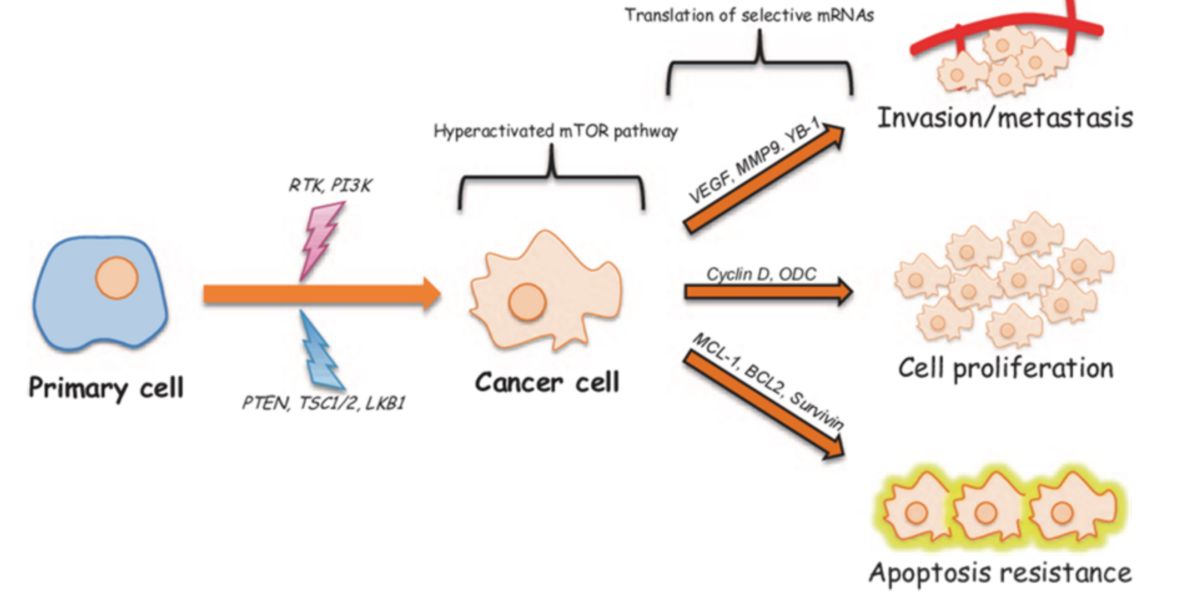
So:
- “… how many hours do I have to fast to completely block the mTOR… ”; or
- “… how many hours do I have to eat so that AMPK doesn’t block the mTOR and prevent me from growing? …”
Not it’s not that simple!
How AMPK works
AMPK, as we have seen, has 3 subunits:
- alpha: is activated by the preventive activation of the kinases that “precede”.
Imagine a cascade, intracellular signaling works like this: proteins or transcription factors are activated that activate some, block others …
And so effects appear physiological.
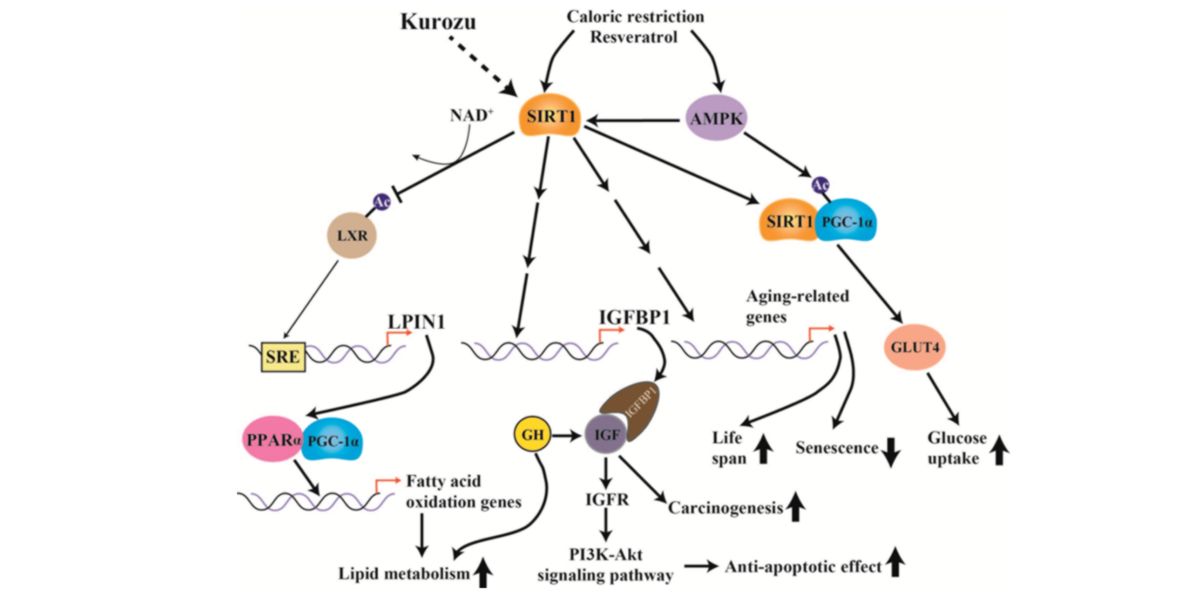
- beta: is an important sensor of glucose concentrations (and glycogen)
- range: is an important energy sensor, sensitive to ADP ratio: AMP.
AMPK activation
AMPK activation through various mechanisms, among other factors:
- Increase the transport of fatty acids to the mitochondria, promoting the oxidation of fats;
- Increase the translocation of GLUT4 on the cell membrane, favoring the entry of glucose into the cell and a hypoglycemic condition;
- Regulates the activation of PGC-1α, promoting mitochondrial biogenesis and inhibits a gluconeogenesis modulator hepatic, preventing the reduction glucose to glycogen.
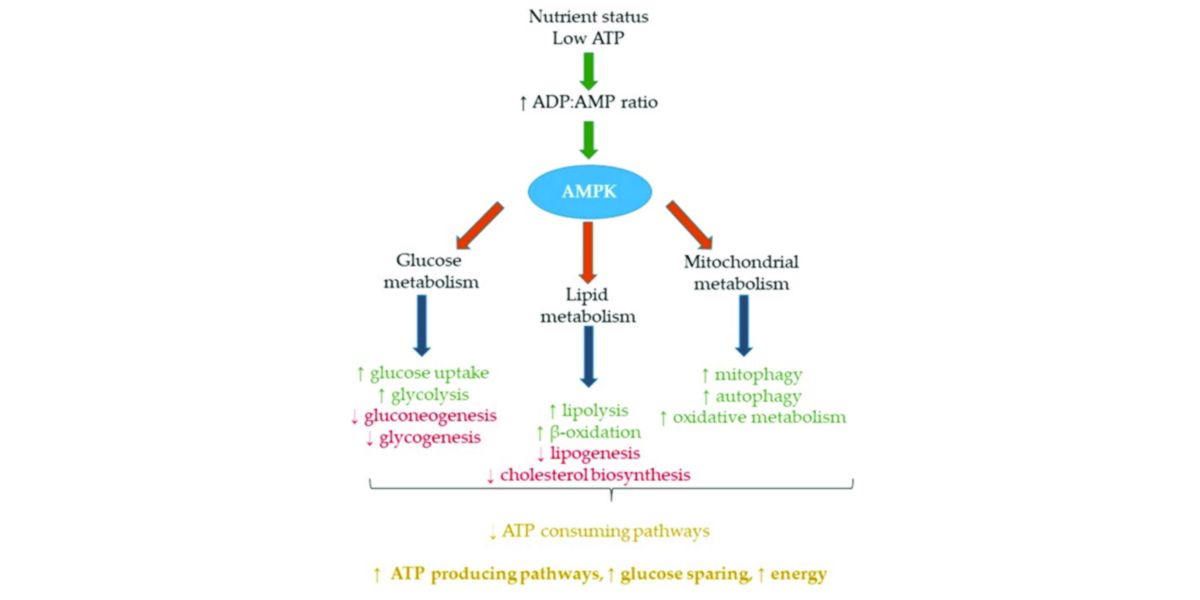
AMPK is an “emergency” kinase, if the energy drops, it detects it and goes into “survival mode” to get it anyway.
Breaks down structures damaged cell phones to get energy; structures that should be recycled because we are well organically, the famous autophagy which will be discussed later.
With the AMPK in the head, not build, destroy and heal.
How mTORC1 works
The mTOR is part of 2 functional complexes: mTORC1 and MTORC2.
The mTORC1 is the most relevant to us, since it is sensitive to our changes in behavior: such as diet or rest.
mTORC2 responds to insulin and growth factors , which , although it is true that they can be modulated by ourselves, it is not that simple.
mTORC2 acts as a promoter of mTORC1 phosphorylation.
When is mTORC1 activated?
Faced with concentrations of glucose in the cell, amino acids and in general energy ;
Also, when cell growth promoters are detected (growth factors also come in here).
The mTOR understands that there is energy, there are reserves, we can start building and spending resources without fear, because we have enough, he notes.
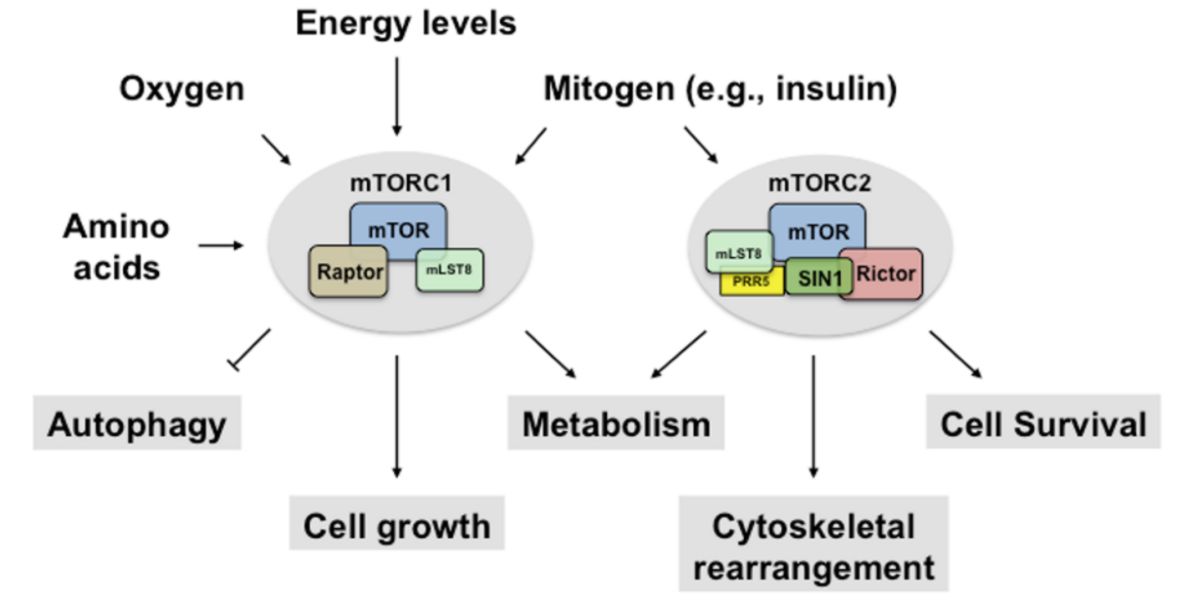
Leucine and mTOR
One of the most discussed topics is the activation of mTORC1 by leucine , which, although true, is once again a partial view of a complex question.
Amino acids in general, their concentration, in particular the presence of leucine and arginine in the cell, modulate the RAPTOR subunit of mTORC1.
They reach it thanks to the activation of a subfamily of GTPase called Rag, which interacts in a unidirectional way with RAPTOR .
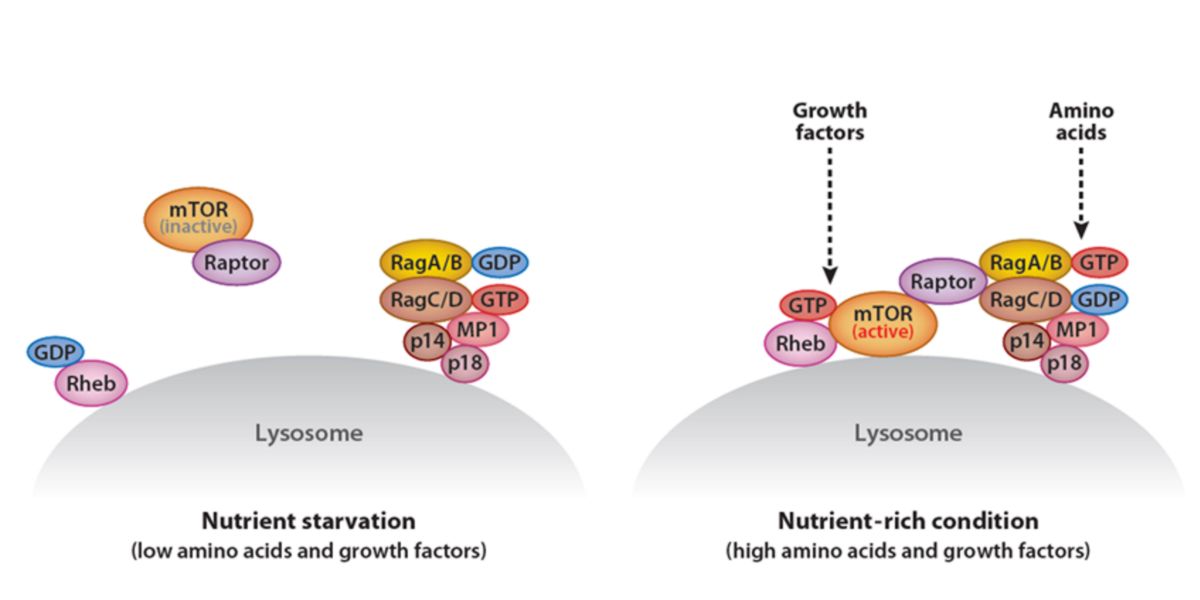
This interaction leads to the activation or inactivation of mTOR and, therefore, to the response that the body will receive. What will be the order: build or destroy?
This is why it is important (among many other things) to consume protein to increase muscle mass; And the calories!
We need a surplus of energy to activate one of the main (but not the only) cell growth mechanism: mTORC1 .
mTORC1 is also an important modulator of ribosomal biogenesis, that is of the proliferation of organelles where proteins are built which will then become part of our muscle tissue.
What is the interaction between AMPK and mTOR
The relationship between AMPK and mTOR is complex and, although it is roughly summarized as: “antagonism”, the mechanisms leave the door open to possible positive interactions between both factors.
A simplified but fairly accurate view of the central skeleton pathway.
mTORC1 is activated by an increase in the concentration of intracellular amino acids ( via Rag / RAPTOR), the general increase in energy availability and the presence of growth factors via mTORC2.
The active ions of mTORC1 inhibits 4EBP1 , a member of the 4EBP family which in turn inhibits eIF4E, an initiator of protein translation.
It also activates the S6 kinase, a protein directly linked to protein synthesis and cell growth.
mTORC1 is directly inhibited by blocking RAPTOR phosphorylation by AMPK, therefore AMPK has a direct mechanism of inhibition of mTORC1 .
Rheb is the most direct promoter of mTORC1 activation, which is also directly blocked by a mechanism independent of AMPK but dependent on the low availability of energy in the cell: PRAK .
AMPK also activates TSC, two functional complexes that block Rheb, so AMPK also has indirect mechanisms to block mTORC1 , TSC is inhibited by activation of the PI3K-Akt-dependent insulin pathway which also regulates mTORC2, so this sub-complex has the ability to address the action of AMPK on mTORC1 inhibition.
What is the relationship with autophagy?
Similarly, both regulate autophagy:
A degrading process in which structurally or functionally damaged cell components are “marked “For degradation (recycling).
Both mechanisms regulate the autophagy process, which in turn regulates processes such as aging, appearance of certain cancers, neuroendocrine alterations…
Conclusions
As long as are physiologically balanced there are no problems to worry about.
No fasting, nothing to limit …, no worry too much about the molecular mechanisms that underlie certain physiological effects and focus on maintaining a lifestyle as healthy as possible , based on your goals.






